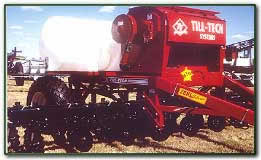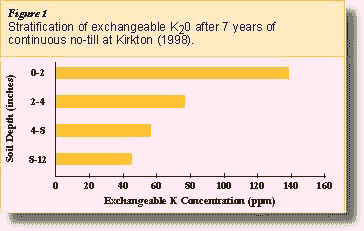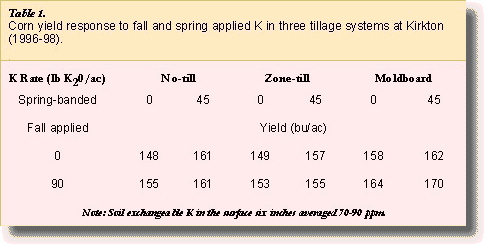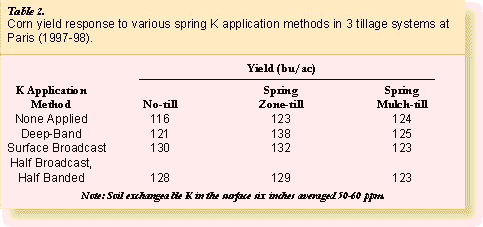Spring-Banded
Potash Increases Conservation-till Corn Yield
By Tony
Vyn, Ken Janovicek and Dragan Galic, Department of Plant Agriculture, University
of Guelph
Effective nutrient management for no-till
corn production is not only dependent on knowing the quantity of nutrient required,
but also on where required nutrients should be placed. A 1996 survey of 54 long-term
no-till fields in Ontario indicated that immobile nutrients such as phosphorous
(P) and potassium (K) have become stratified. Soil K concentrations were relatively
high within the surface two inches and were relatively low below four inches.
Stratification of K can result in inadequate K availability for both corn and
soybeans, even when standard soil tests indicate that sufficient K should be
available. (Refer to February issue of Ontario Corn Producer for details.)

Adequate
K availability is especially crucial for corn plants between the 10-leaf stage
(knee high) and silking, when up to 80 per cent of the total K uptake will occur.
Dry soil conditions at this time can reduce K uptake. Stratified no-till fields
are especially vulnerable to poor K uptake during prolonged drought conditions
because of limited root function close to the soil surface where K levels are
the highest.
Until recently, corn farmers had just two placement options for potash. They
could either broadcast or apply in a starter band at planting. Sometimes they
did both, in part because they were limited in the amount of potash they could
apply close to the seed, especially when relatively large amounts of N were
applied close to the row at planting as well. Recent availability of air delivery
systems for dry fertilizers has now made possible a third application option
of deep banding in the row area. Deep banding is usually combined with pre-planting
zone-tillage with coulters and/or shanks in the fall or spring.
This article summarizes some of the on-farm research conducted from 1996 to
1998 evaluating the effectiveness of various potash placement options for corn
planted in long-term no-till fields with significant K stratification.
Fall versus
Spring Banding
Five experiments which
evaluated fall and spring (starter-band) potash application options in three
tillage systems were conducted on fields which were in continuous no-till for
a minimum of seven years near Kirkton (Perth County) and Belmont (Elgin County).
The degree of K stratification at the 1998 Kirkton site (Figure 1) is typical
of the K stratification observed at the

other no-till
fields in this study. Potash was fall applied at a rate of 90 lb K2O/ac by surface
broadcasting in the no-till system, surface broadcasting and plowing under in
the fall moldboard system, and deep-banding six inches deep in the zone-till
system. Fall applied potash in the zone-till system was applied in conjunction
with fall zone-tillage operations. Two rates of starter potash were applied
(0 or 45 lb K2O/ac) in a two-inch by two-inch starter-band at planting. Actual
nitrogen (N) and P was applied at rates of 27 lb/ac each in the starter band
for both fall K rates in all tillage systems.
Average yields for Kirkton shown in Table 1 are representative of starter potash
responses observed at both Belmont and Kirkton when soil exchangeable K tests
were in the medium range (70-100 ppm). When the no-till system was continued,
corn yields increased 13 bu/ac with starter potash alone, compared to just seven
bu/ac with broadcasting double the potash rate. Starter banding potash was also
more beneficial to corn yields than deep banding alone in zone-till, and than
broadcast

application
before plowing in the moldboard treatment.
When soil K test levels were very high (i.e. above 160 ppm) there was no corn
yield benefit to potash application by any method, even though stratification
was significant after years of no-till (Belmont 1997, data not shown).
Plowing
After No-Till?
Some agronomists suggest
periodic plowing of no-till fields is an effective method of increasing availability
of stratified K. Fall moldboard plowing at Kirkton did increase corn yield;
however, the size of the yield increase was the same where potash was not applied
and where the highest rate of potash was applied (90 lb K2O/ac fall broadcast
plus 45 lb K2O/ac starter band). It is interesting to note that when only starter
potash was applied, moldboard and no-till yields were similar. This suggests
yield response to tillage on soils with medium levels of exchangeable K may
be affected by K fertility and/or by both rate and method of K application.
Comparison
of Spring Application Options
We also compared three
spring potash application methods in three tillage systems on a loam soil that
has been in continuous no-till for 11 years near Paris (Brant County). The potash
application methods were surface broadcast, half surface broadcast plus half
applied in a two-inch by two-inch planter band, and deep (six-inch) in-row band.
The tillage systems were no-till, spring zone-till (six- to seven-inches deep)
and spring mulch-till with a field cultivator. Potash was applied at a total
rate

of 115
lb K2O/ac and any broadcasting occurred before tillage.
Deep-banded potash in a spring zone-till system produced the highest corn yield
on this drought-susceptible loam soil (Table 2). Surface broadcast potash also
increased no-till and zone-till yields, but not to the same levels obtained
when potash was deep banded in the zone-till system. No-till and zone-till yields
were often higher than mulch-till when potash was applied, so using tillage
to incorporate K was not helpful at this site.
Conclusions
and Recommendations
Shallow-banded potash
in two-inch by two-inch planter starter bands is available to corn in no-till
and zone-till systems. In fact, some of the largest no-till and zone-till yield
responses to potash were observed (on soils with a medium exchangeable K rating
only) when significant amounts of potash (45 lb K2O/ac) were included in the
starter fertilizer blend.
The availability of shallow-placed potash in this study may, in part, be due
to the fact that corn was planted in rotation with wheat, where the high surface
residue cover and improved soil structure conditions may stimulate more root
growth close to the soil surface. Whether the same response to potash applied
in a starter band will occur when corn is planted no-till following soybeans
needs more investigation.
We recommend that no-till and zone-till corn producers with fields testing in
the low-to-medium range consider applying significant amounts of potash (e.g.,
30-50 lb K2O/ac) in a two-inch by two-inch band at planting. Relying solely
on broadcast applications of K will not be adequate if these fields continue
in no-till or some form of zone-till. However, on soils with an exchangeable
K rating less than 80 ppm, potash should be bulk applied in addition to the
starter-band application. Growers attempting to produce corn on drought-susceptible,
K-deficient soils may want to consider deep applying potash in a zone-till system
since this resulted in substantial yield increases.
We realize there has been a move away from two-inch by two-inch dry-starter
fertilizer band application, primarily because of the time and equipment costs.
However, recent advancements in air application technology (see photo) reduces
the costs and time involved with applying dry starter fertilizers at planting.
Besides being easily mounted on coulter carts, these units can also be readily
mounted directly onto the planter. Also, many no-till producers stopped banding
because they could not get dry fertilizer coulters to band starter fertilizer
at a constant depth. Recently, new no-till dry fertilizer coulters which are
designed to more consistently apply fertilizer bands at a constant depth have
become available.
Finally, although in the ideal world farmers would not begin continuous no-till
until their soils tested over 120 ppm exchangeable K, intensive tillage operations
are not essential after several years of no-till if the sole purpose is to incorporate
potash on medium testing K soils. Proper banding is all that's necessary, making
sure that total band applied N plus K in starter does not exceed 80 lb/ac (for
30-inch rows). There are good alternatives now to keep erosion loss low, input
costs low and corn yields high.
Acknowledgements
We wish to recognize the financial
support provided by the Ontario Corn Producers Association, Potash and Phosphate
Institute of Canada, Pioneer Hi-Bred International Ltd. and the Grow Ontario
Investment Program. We also wish to acknowledge Becker Farm Equipment for supplying
the Trans-till and Till-Tech Systems Ltd. for providing the potash application
equipment. Cooperating farmers were Bill Denham (Kirkton), Bill Erickson (Belmont)
and Clinton Potruff (Paris).
Back
to Top

 Adequate
K availability is especially crucial for corn plants between the 10-leaf stage
(knee high) and silking, when up to 80 per cent of the total K uptake will occur.
Dry soil conditions at this time can reduce K uptake. Stratified no-till fields
are especially vulnerable to poor K uptake during prolonged drought conditions
because of limited root function close to the soil surface where K levels are
the highest.
Adequate
K availability is especially crucial for corn plants between the 10-leaf stage
(knee high) and silking, when up to 80 per cent of the total K uptake will occur.
Dry soil conditions at this time can reduce K uptake. Stratified no-till fields
are especially vulnerable to poor K uptake during prolonged drought conditions
because of limited root function close to the soil surface where K levels are
the highest. other no-till
fields in this study. Potash was fall applied at a rate of 90 lb K2O/ac by surface
broadcasting in the no-till system, surface broadcasting and plowing under in
the fall moldboard system, and deep-banding six inches deep in the zone-till
system. Fall applied potash in the zone-till system was applied in conjunction
with fall zone-tillage operations. Two rates of starter potash were applied
(0 or 45 lb K2O/ac) in a two-inch by two-inch starter-band at planting. Actual
nitrogen (N) and P was applied at rates of 27 lb/ac each in the starter band
for both fall K rates in all tillage systems.
other no-till
fields in this study. Potash was fall applied at a rate of 90 lb K2O/ac by surface
broadcasting in the no-till system, surface broadcasting and plowing under in
the fall moldboard system, and deep-banding six inches deep in the zone-till
system. Fall applied potash in the zone-till system was applied in conjunction
with fall zone-tillage operations. Two rates of starter potash were applied
(0 or 45 lb K2O/ac) in a two-inch by two-inch starter-band at planting. Actual
nitrogen (N) and P was applied at rates of 27 lb/ac each in the starter band
for both fall K rates in all tillage systems. application
before plowing in the moldboard treatment.
application
before plowing in the moldboard treatment. of 115
lb K2O/ac and any broadcasting occurred before tillage.
of 115
lb K2O/ac and any broadcasting occurred before tillage.